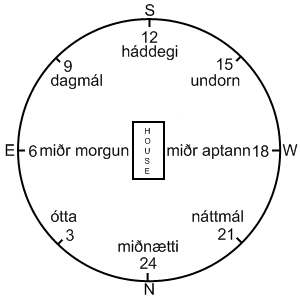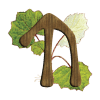
Telling Time
The Northerners didn’t have watches so they didn’t divide the day into hours. They counted time by where the sun was in the sky in relation to their home. The movement of the sun over the sky – sólarhringr (sun ring), was divided into eight equal parts called ætt or eykt.
An example of a sun ring could look something like this:

The image shows the sun ring around a house with directions, our times and the Northerners’ names.
They counted time by the position of the sun when it was in the south, southwest, west, northwest, north, northeast, east, and southeast.
These times or positions were called dagmark (day mark) and each had a name; hádegi (when the sun was in the south), undorn or eykt (when the sun was in the southwest), miðr aptann (when the sun was in the west), náttmál (when the sun was in the northwest), miðnætti (when the sun was in the north), ótta (when the sun was in the northeast), miðr morgun (when the sun was in the east) and dagmál (when the sun was in the southeast).
When the sun was in the south, they said the sun was in hádegistað, in the southwest it was in undornstað, in the west miðr aptannstað, in the southeast dagmálstað and so on.
If they wished to name the time between two of these, they could say half way in between dagmálstað and hádegistað.
They also noticed objects in the terrain where the sun was at certain times. These landmarks were used as a watch for most people, since the sun would be over the same landmark at the same time every day. The only difference would be the height over the horizon. These landmarks often got their names from the times.
Throughout the Nordic countries, there are lots of names like Middagsfjellet, Middagshognan, Miðaptansdrangur and Undornsfell.
The most important day mark was hádegi (midday). When the sun was in the south, our 12:00.
